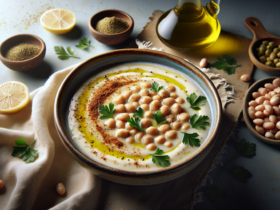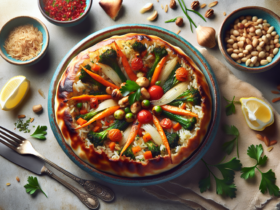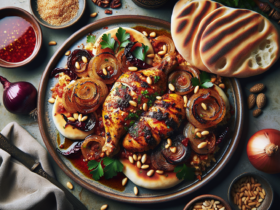Ka’ek Al-Quds, or Jerusalem bread, is a beloved staple that embodies the warmth and hospitality of Palestinian culture. This crusty bread, with its golden exterior and sesame seed topping, brings to mind family gatherings, festive celebrations, and the rich culinary traditions of Jerusalem. Each bite offers a satisfying crunch, revealing a soft, airy interior that pairs wonderfully with a variety of dishes. The aroma of freshly baked bread fills the air, inviting loved ones to gather around the table, making every meal a special occasion.
The origins of Ka’ek Al-Quds can be traced back to ancient times, where bread-making was not just a culinary practice but a fundamental aspect of daily life in the region. Traditionally, this bread was baked in communal ovens, fostering a sense of community among families. Over the years, variations of this bread have emerged throughout the Middle East, yet the Jerusalem version remains distinct due to its unique shape and generous sesame coating, reflecting the local ingredients and flavors of the area.
What sets Ka’ek Al-Quds apart is its delightful texture and the way it captures the essence of Jerusalem’s culinary heritage. The use of high-quality flour and the traditional fermentation process result in a bread that is both light and hearty. The generous sprinkle of sesame seeds adds not only a nutty flavor but also a crunchy contrast to the soft dough. This bread is versatile enough to be enjoyed on its own or as an accompaniment to dips, stews, or salads.
The Must-Do’s
To ensure authenticity, kneading the dough thoroughly is crucial, as it develops the gluten structure necessary for the desired texture. Allowing the dough to rise adequately is another key step; this fermentation enhances the flavor and contributes to the lightness of the bread. Finally, the sesame seed coating should be generous, as it not only adds flavor but also provides a traditional look that is characteristic of this beloved bread.
Experience the delightful crunch and rich flavor of this traditional Jerusalem sesame bread, perfect for any meal or snack. Store in an airtight container at room temperature for up to 3 days. Reheat in the oven for best texture.
In a large mixing bowl, combine the warm water, sugar, and active dry yeast. Let it sit for about 10 minutes until frothy.
Add the olive oil and salt to the yeast mixture, then gradually incorporate the flour, mixing until a dough forms.
Knead the dough on a floured surface for about 10 minutes until smooth and elastic. Place it in a greased bowl, cover with a damp cloth, and let it rise in a warm place for 1 hour or until doubled in size.
Preheat your oven to 220°C (428°F). Once the dough has risen, punch it down and divide it into 6 equal portions.
Roll each portion into a long rope, then shape it into an oblong ring, pinching the ends together to seal.
Brush each ring with water and dip them into sesame seeds, ensuring they are well-coated.
Place the rings on a baking sheet lined with parchment paper and allow them to rest for another 15 minutes.
Bake in the preheated oven for 20-25 minutes or until golden brown and crusty. Remove from the oven and let cool on a wire rack.
Ingredients
Pro Tips
For an extra flavor boost, consider adding a teaspoon of za’atar to the dough. If you prefer a softer crust, cover the bread with a cloth while it cools. To avoid common pitfalls, ensure your water is not too hot when activating the yeast, as this can kill the yeast. Additionally, do not skip the proofing step, as it is essential for achieving a light and airy crumb.
Serving Suggestions
Ka’ek Al-Quds is best served warm, accompanied by a drizzle of high-quality olive oil or a selection of dips like hummus or baba ghanoush. It also pairs beautifully with fresh salads, grilled meats, or stews, making it a versatile addition to any meal.
Garnishing & Presentation
To enhance the visual appeal of your Ka’ek Al-Quds, consider serving it on a rustic wooden board, garnished with fresh herbs such as parsley or mint. A sprinkle of additional sesame seeds on top before serving can elevate its presentation, and a small bowl of olive oil for dipping provides a delicious touch.
الخبز في البيت طعام لكل الناس
This Palestinian proverb translates to ‘Bread at home is food for everyone.’ It emphasizes the importance of bread in Palestinian culture, symbolizing sharing and community, particularly when it comes to meals like Ka’ek Al-Quds.
As a child, I remember the intoxicating smell of Ka’ek Al-Quds wafting through my grandmother’s kitchen. Every gathering was marked by this beloved bread, bringing family together around the table. It holds a special place in my heart, representing not just nourishment but the love and connection shared over meals. For me, baking this bread is a way to honor my heritage and keep those cherished memories alive.
Equipment Needed
- Mixing bowl
- Baking sheet
- Parchment paper
- Rolling pin
- Wire rack
Cooking Techniques
Kneading
This technique develops gluten in the dough, giving the bread its structure and chewiness.
Proofing
Allowing the dough to rise helps develop flavor and texture in the final bread.
Serving Suggestions
- Serve warm with olive oil for dipping or alongside hummus and salads.
Garnish Suggestions
- Sprinkle with additional sesame seeds before serving for a beautiful presentation.




![[object Object]](https://haboba.com/wp-content/uploads/2025/03/Refreshing-Parsley-and-Bulgur-Salad-with-Lemon-Dressing-280x210.png)









Leave a Review